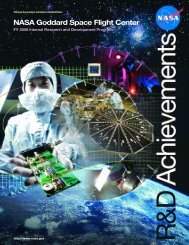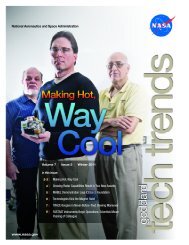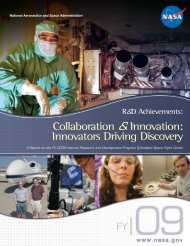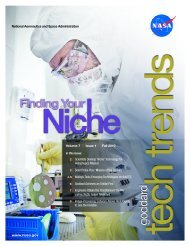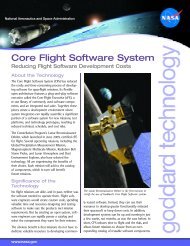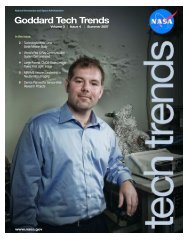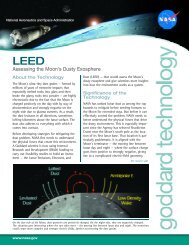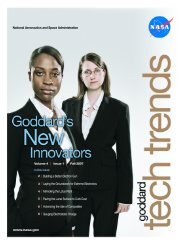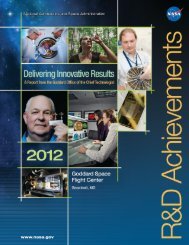Goddard Tech Trends - NASA's Goddard Technology Management ...
Goddard Tech Trends - NASA's Goddard Technology Management ...
Goddard Tech Trends - NASA's Goddard Technology Management ...
Create successful ePaper yourself
Turn your PDF publications into a flip-book with our unique Google optimized e-Paper software.
Historic Test Brings Laser Spacecraft Ranging to a New Era<br />
<strong>Tech</strong>nology Slated for Use on the Lunar Reconnaissance Orbiter<br />
03<br />
An experiment in which an Earth-based observatory successfully<br />
exchanged laser pulses with the MESSENGER<br />
spacecraft while the two were millions of miles apart has<br />
helped to convince mission planners to include the same<br />
technology on the Lunar Reconnaissance Orbiter (LRO),<br />
which will launch in 2008 to map the lunar surface.<br />
The hope is that the highly precise laser-ranging technology<br />
demonstrated last spring with MESSENGER’s<br />
Mercury Laser Altimeter (MLA) will allow scientists to<br />
measure with centimeter accuracy the disturbances to<br />
LRO’s orbit around the Moon. With that information,<br />
they hope to learn more about the Moon’s well-known<br />
gravitational anomalies, which NASA first measured during<br />
the early days of the space program.<br />
“We proposed a subsystem for the Lunar Reconnaissance<br />
Orbiter and this experiment was the proof that it would<br />
work,” said Xiaoli Sun, MLA Instrument Scientist, referring<br />
to the record-breaking test that he and other MLA<br />
team members conducted from the <strong>Goddard</strong><br />
Geophysical and Astronomical Observatory in late May.<br />
“Our test with MESSENGER helped to convince us that<br />
we could do this with LRO.”<br />
Historic First<br />
The test between MESSENGER, which stands for<br />
MErcury Surface, Space ENvironment, GEochemistry<br />
and Ranging, and the <strong>Goddard</strong> observatory made headlines<br />
because it represented the first time scientists were<br />
able to conduct a two-way exchange of laser signals over<br />
vast distances in space. At the time, MESSENGER was 15<br />
million miles from Earth on its 6.6-year journey to<br />
Mercury, where it will map the planet’s surface.<br />
In addition to proving that such an exchange could<br />
occur at interplanetary distances, the test demonstrated<br />
its sub-nanosecond timing accuracy. It also calibrated the<br />
laser pointing and receiver bore sight, which was the<br />
principal reason for the test, Sun said.<br />
Long Time Coming<br />
NASA has long wanted to demonstrate the laser-ranging<br />
capability across deep space because of its widespread<br />
potential. In addition to determining orbital positioning<br />
needed for fundamental geophysical studies, the same<br />
laser technology can dramatically improve<br />
Continued, Page 6<br />
<strong>Goddard</strong> <strong>Tech</strong> <strong>Trends</strong><br />
<strong>Goddard</strong> technologists used this 1.2-meter Telescope Tracking Facility at the <strong>Goddard</strong> Geophysical and Astronomical<br />
Observatory to fire laser pulses to MESSENGER.<br />
Inset: A crane lifted MESSENGER out of the thermal vacuum chamber at the <strong>Goddard</strong> Space Flight Center after it completed<br />
5 weeks of rigorous tests to show that it could withstand the wide range of hot and cold temperatures that it would<br />
encounter on its journey to and mission around Mercury.<br />
Volume 2 Issue 3 Spring 2006<br />
http://gsfctechnology.gsfc.nasa.gov



